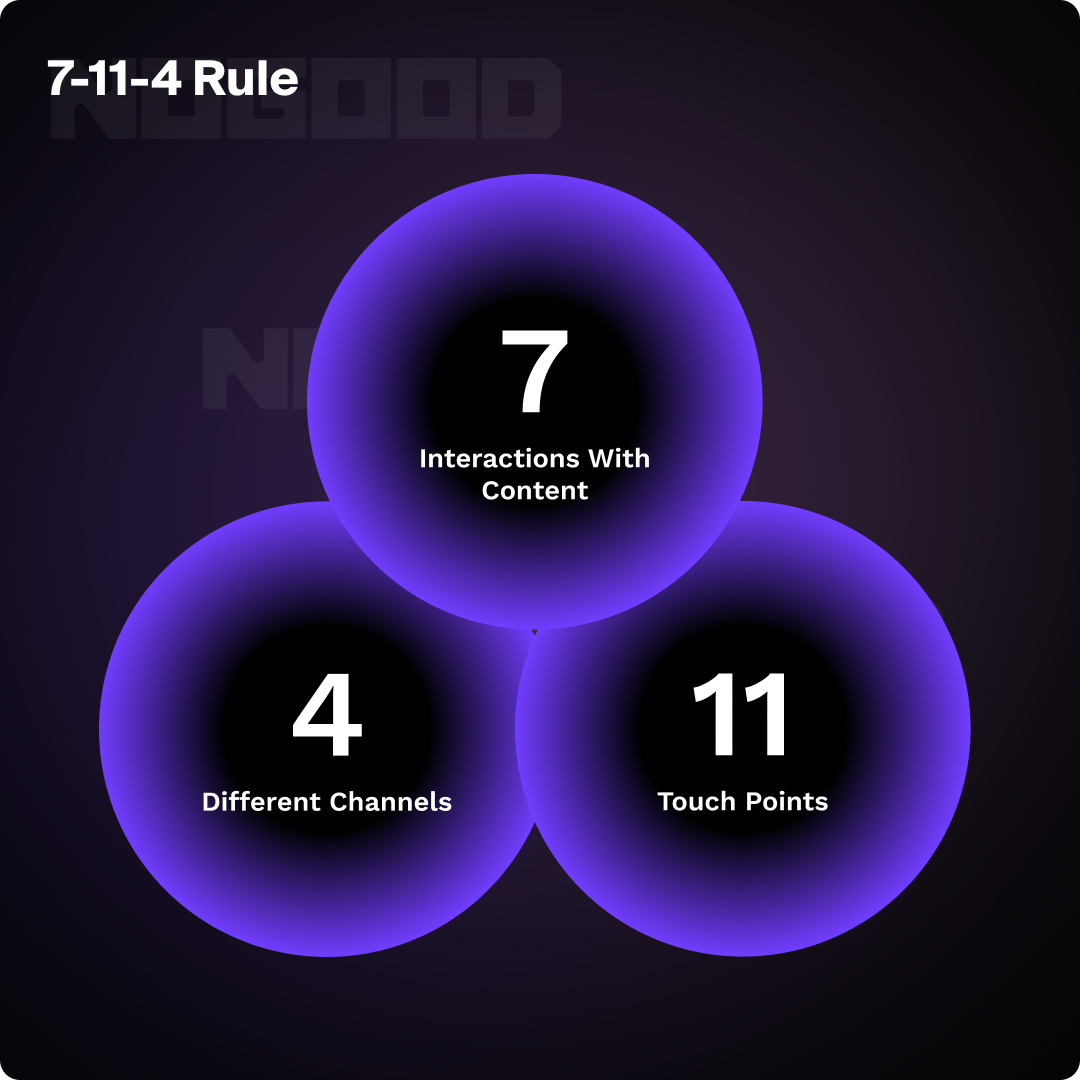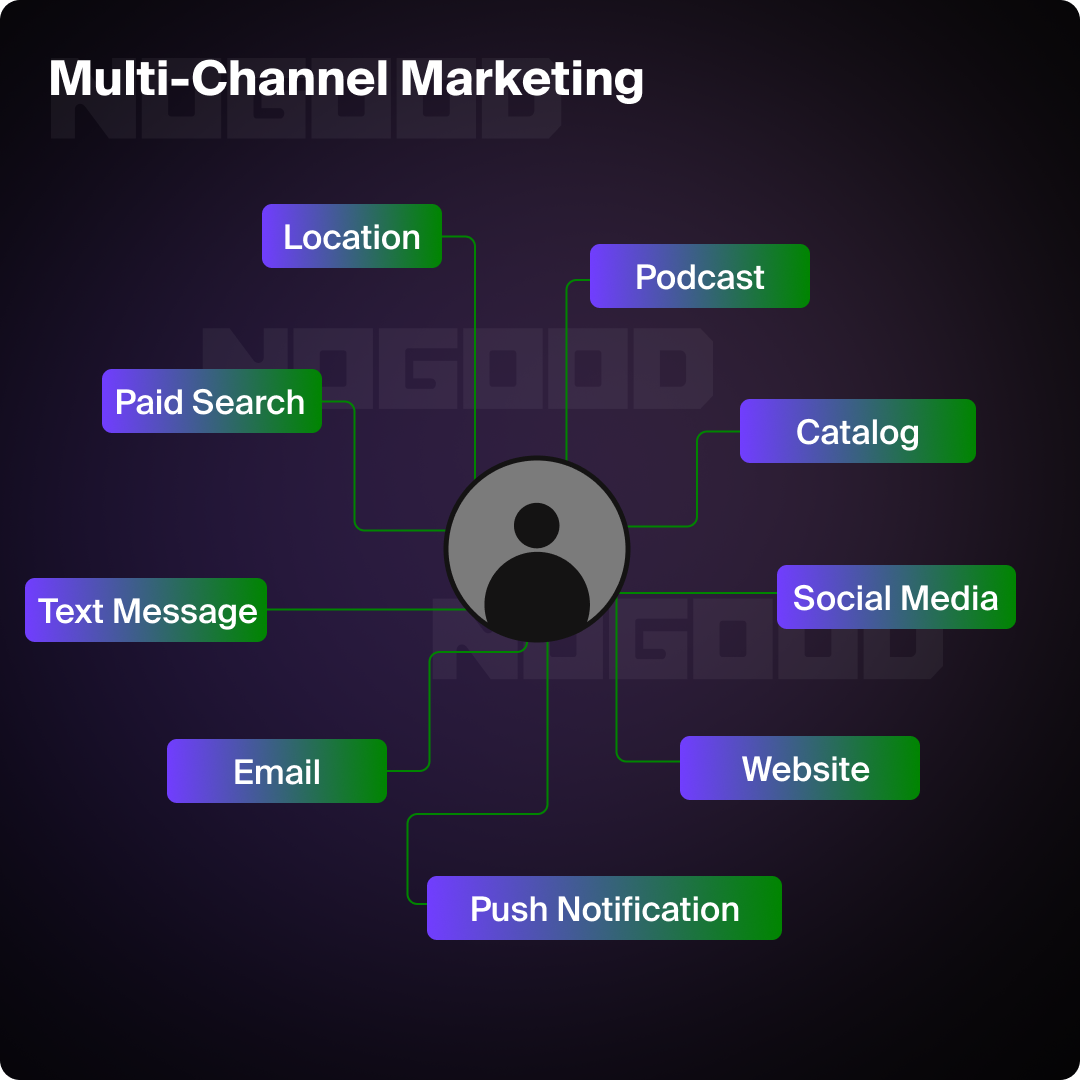Think about the last time you made a purchase decision. Did you see an ad, click once, and buy on the spot? Most likely not. You most probably compared on the web, checked reviews, maybe even asked your favorite answer engine, and circled back multiple times before committing. That’s not just you; that’s every customer today. And it’s exactly why a multi-channel strategy is no longer optional.
The seeds of this idea go back to 1930, when Dr. Jeffrey Lant introduced the “Rule of 7” in the film industry. The rule states that people need to see a message at least seven times before taking action. This highlighted the importance of consistent, repeated exposure through multiple channels to build brand awareness, trust, and ultimately drive conversions. For decades, that logic worked because journeys were relatively linear. You placed ads, sent mailers, ran TV spots, and exposure did its job.
Fast forward to today, and the journey looks nothing like a straight line. This rule received a makeover in the form of the “7-11-4 Rule,” most frequently attributed to Google. This method suggests modern buyers need to consume seven hours of content, across eleven touchpoints, in at least four formats before they trust a brand enough to act. These seven hours of content and eleven touchpoints don’t happen in one place. They’re scattered across platforms (Social Media, Organic Search, Answer Engines, etc.) and various content types (Blog articles, video, email, podcast, etc.), often happening out of sequence and over weeks or months.
As brand marketers, optimizing campaigns in silos or judging success based on a single touchpoint isn’t an option. Instead, our job is to design, measure, and refine the entire journey across channels; making sure every interaction builds customers’ affinity towards the brand and eventually leads to a conversion.

In this article, you’ll learn how to understand your customers, map critical paths across touchpoints, identify and fix friction, integrate tools and teams, create seamless cross-channel experiences, and measure what truly matters for you.
Step 1: Build Customer Profiles That Actually Work
Customer profiles are the foundations of any marketing activity; you need to know who your customer is. Every multi-channel strategy starts with clarity on who you’re designing it for. Without strong profiles, you’ll spread effort across channels without knowing what matters most.
Why It Matters: Example
A CFO evaluating enterprise accounting software for a multinational firm and a small business owner looking for an affordable, easy-to-use tool to manage invoices and expenses may both use multiple channels, but the content, timing, and triggers that influence them are quite different.
How to Do It
If you’re building profiles for your own business, here’s a practical approach:
- Start with your data: Use CRM, website analytics, and email engagement to see patterns, who your customers are, where they start, what they click, and which content works.
- Layer qualitative insights: Ask customers where they first heard of you, what channels they trust, etc. Sales and support teams often have these insights through their interactions with the customers.
- Connect personas to channels: For each profile, document preferred touchpoints, content formats they engage with, and triggers that push them forward in the journey.
Human-Centered Design Thinking
- Interview customers about their struggles.
- Observe actual behavior across channels via behavior tracking tools like MS Clarity, Hotjar, etc.
- Use empathy mapping to capture what they think, feel, see, and hear at each channel.
Pro Tip: Don’t overcomplicate your persona mapping. Three to four strong personas tied to data will outperform 12 shallow ones.
Step 2: Map the Multi-Channel Journey
Once you know who your customers are, the next step is tracing the path they potentially take across channels. Customer profiles tell you who your customers are. Journey maps show us how they behave.

Why It Matters
If you don’t map the journey, you’ll default to “channel-first” marketing, optimizing email campaigns, paid ads, or social media in silos. But customers don’t see silos, they experience journeys as either a one complete unified flow or a broken or convoluted journey.
How to Do It
- Identify milestones: Initial brand awareness and discovery, research and information gathering, purchase and conversion, account setup and onboarding, engagement, and advocacy.
- List every touchpoint: Start from awareness (ad platforms, organic search, AI search, social, etc.) through purchase (website, sales calls, checkout, emails, and app notifications) to loyalty (support, retention campaigns, and loyalty page sign-ins).
- Track entry and exit points: Where do customers typically start? Where do they drop off?
Step 3: Diagnose Pain Points & Optimize High-Impact Moments
Zoom in on where customers struggle; remember, not all touchpoints are equal. Some are “moments of truth” that define how customers feel about your brand.
Why It Matters
Friction isn’t just inconvenient; it costs revenue. Abandoned carts, unanswered questions, and repeated forms all push customers toward competitors.
How to Do It
- Identify friction: Look for gapsl are people asked to repeat information? Do they lose context when switching from mobile to desktop? Are they asking for specific information when sales connect with them?
- Look for common issues:
- Confusing navigation
- Missing or hard-to-find info
- Complicated checkouts
- Tedious logins
- Poor handoffs between channels
- Prioritize frequent, necessary, or emotional moments:
- First impressions (ads, homepage)
- Checkout flow
- Account login
- Customer support interactions
Step 4: Integrate Tools & Technology
Profiles and journey maps are useless without the right tech stack to bring them to life.
Why It Matters
Customers expect seamlessness. If your app, website, and call center don’t share context, it could make users feel like they’re starting from scratch every time. Most companies struggle here as data lives in different systems: CRM, marketing automation, website analytics, and support tickets.
If you can’t integrate them, you’ll never deliver seamless multi-channel experiences.
How to Do It
- Pick your CRM as the hub: All customer interactions (sales, support, marketing) should flow into one source of truth.
- Layer automation tools: Connect your CRM with marketing automation to trigger contextual outreach. For example, if a lead downloads a whitepaper, follow up with a related webinar invite.
- Add analytics on top: Use attribution tools to see which channels influence deals or purchases. Do remember, there are channels which will never get any attribution here.
- Use AI carefully: AI can personalize at scale, but only if fed quality data. Test predictive lead scoring and personalized recommendations.
Integration is about data flow. You should invest in a tool that helps you connect CRM and give marketing, sales, and support the same view, or at least the flexibility to build this view.
Step 5: Create Seamless Transitions Across Channels
Seamless transition between channels is the key to a multichannel customer journey.
Why It Matters
True multi‑channel journeys aren’t about hopping from one channel to the next; they are about carrying context forward. A survey by Gartner shows 93% of customers reported high satisfaction (CSAT) when they experienced seamless transitions between channels, even if one of those channels was physical and the other digital.
In customer service specifically, the same survey showed that customers with seamless transitions across self-service and assisted channels spent 27% less time with agents, while still achieving satisfaction. That adds up to both happier customers and lower costs.

How to Do It
Here’s how to turn handoffs from friction points into fluid experiences:
- Conduct “mystery shoppers” across channels: Play the customer. Add a product to your cart on mobile, then switch to desktop: does your cart carry over? Start a support chat, then escalate to phone: does the agent have context? If not, identify where context drops and fix it.
- Unify data and context: Ensure customer actions and profile data flow across systems, web, app, in-store, and chat. A centralized CRM or unified customer profile enables agents and automated systems to personalize seamlessly.
- Design consistency in messaging and branding: Handoff disruption isn’t just functional, it’s perceptual too. Visual branding, tone, navigation, and value messaging should be consistent. This ensures customers feel they’re dealing with one brand, not different teams.
- Next best action: Every action should lead naturally to the next. For instance, if a user showed interest in Product 1, the next time the same user visits your website, the hero banner can be replaced with Product 1 offering.
- Personalize transition: Cart abandonment emails should reflect the exact items left behind, or a sales rep should know which whitepapers a lead downloaded.
Step 6: Measure Success & Optimize
Multi-channel journeys involve so many touchpoints that the performance by channel is almost always blurry.
Why It Matters
Identifying the true value of a channel can be tricky because not all channels are measured by the same metrics. For example, a Reddit thread might generate significant visibility and drive brand discovery, but it won’t show up in your performance dashboards since earned platforms don’t track impressions, clicks, or conversions the way paid channels do.
How to Do It
- Define clear KPIs for each channel.
- Acquisition: CAC, Attribution per channel, CPC
- Engagement: Repeat visits, CTR, Time spent on website
- Conversion: Demo-to-deal rate, Cart completion
- Retention: CSAT, NPS
- Choose the right model. Identify channels that can be optimized for last click, but don’t solely rely on it for optimizing for the brand. Multi-touch attribution could help reflect performance in the case of complex journeys.
- Run controlled experiments. A/B test messaging across channels, not just within one.
- Iterate. Adopt a test, learn from it, and scale as you deem fit.
- Fit in Marketing Mix Modeling. Multi-Touch Attribution could miss the bigger picture, especially for offline or earned media like free PR, Reddit threads, or influencer shoutouts. Marketing Mix Modeling (MMM) could help solve this by analyzing aggregate data (sales, spend, external factors) to estimate the true contribution of each channel.
MMM helps with:
- Combining the impact from a variety of platforms.
- Reallocating budgets based on true ROI.
- Forecast “what-if” scenarios for spend shifts across channels.
- Capture halo effects (e.g., a Free PR story boosting search traffic).
Pitfalls to Avoid & Tips to follow
- Disconnected data silos: Customers forced to repeat information. Customers have to repeat themselves because the systems don’t share information is a very poor experience. Users should be able to continue from where they left off. This could be either in the form of content continuation or journey continuation.
- Over-automation: Bots and automated flows that fail to escalate to humans when needed can impact user trust and experience. Automation should help simplify and reduce human efforts, but shouldn’t alienate the user.
- Ignoring post-purchase journey: Remember, it could be cheaper to retain a customer than acquire a new one, and loyal customers often become advocates.
- Predictive analytics: Instead of waiting for customers to drop off, data can signal who’s at risk. For example, if a SaaS platform detects declining logins, it can trigger an educational campaign or human outreach before cancellation.
Conclusion: Turning Multi-Channel Journeys Into Growth Engines
Multi-channel is how customers actually buy today. Journeys are fragmented, but brands that connect the dots win. Companies with strong multi-channel engagement see 89% higher customer retention.
To stay competitive, marketers must:
- Design connected journeys instead of isolated campaigns.
- Remove friction and focus on high-impact moments.
- Measure beyond the regular metrics to understand the impact of each channel
When journeys are seamless, customers don’t just convert, they stay, return, and advocate for your brand.






